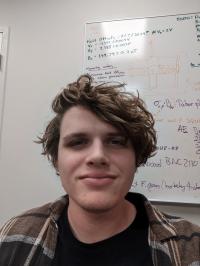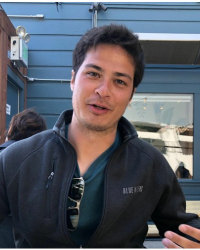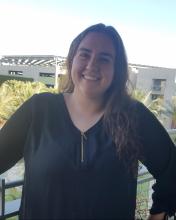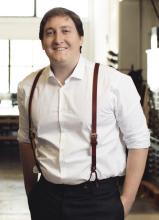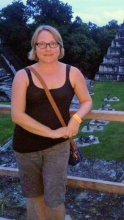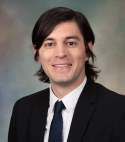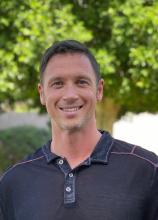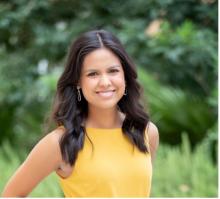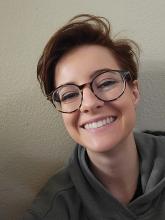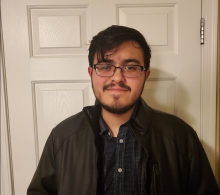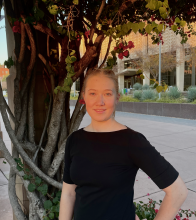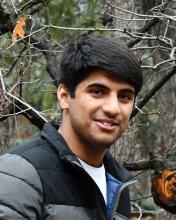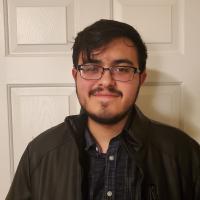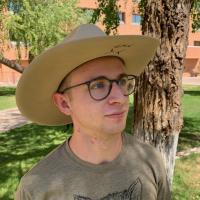
Undergraduate Research Symposium
A place for physics majors to share their research and gain valuable presentation experience.
Event Information
Date: Friday, April 11, 2025
Time: 1:00-4:00p
Location: PSF 186
Presenter Information
Presenters must be available in-person during the entirety of the symposium. During the event presenters should be prepared to answer questions about their research from attendees and judges.
Poster Guidelines
Each student will need to create a research poster. We recommend using Microsoft PowerPoint to design your poster. The Department of Physics will cover the cost of printing one (1) research poster for each presenter. Posters should be no larger than 36"x48", horizontal orientation. Presenters may elect to print their poster at their own cost. Deadline to submit a poster to department for printing is March 28, 2025.
Posters must include the following:
- Presenter's Name
- Title
- Research Advisor
- Collaborators
- Sources
We recommend that you have your research advisor review all information for accuracy before printing.
Resources:
Awards
Judges will award three research scholarships to eligible symposium presenters.
Department of Physics Research Awards
1 award at $2000
1 award at $1000
Eligibility Requirements:
- Student must be an active physics major.
- Student must be conducting physics-related research.
- Student research advisor may be outside of the physics department.
Women in Physics Award for Undergraduate Research
1 award at $700
Eligibility Requirements:
- Student must be an active physics major.
- Student must be conducting physics-related research.
- Student research advisor may be outside of the physics department.
- Student identifies as female.
Rick and John Jacob Award for Undergraduate Research
1 award at $300
Eligibility Requirements:
- Student must be an active physics major.
- Student must be conducting physics-related research.
- Student research advisor must be in the physics department.
Meet our 2025 judges
Jesse Giron
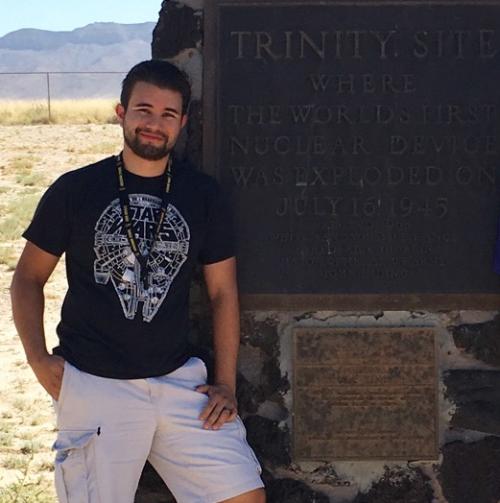
Dr. Jesse Giron is a R&D Scientist at Los Alamos National Laboratory. He received his Ph. D. in Physics in May 2021 under the guidance of Prof. Richard Lebed studying exotic hadrons. He received his B. S. and M. S. in 2017 and 2019, respectively, in Physics at Arizona State University.
Taylor Colburn

Taylor Colburn is a 4th year PhD student in theoretical biophysics in the Matyushov lab. His research focuses on proteins out-of-equilibrium, with a special interest in ergodicity-breaking as a mechanism for biological function.
Past Judges
Meet our student presenters
Krish Majethia
As a physics and mathematics double major, I am passionate about applying scientific research to develop practical, impactful solutions. My current research focuses on color-correcting lenses for colorblindness, with the goal of creating affordable, accessible solutions that improve daily life for those affected. I work at SciHub, where we innovate at the intersection of art, science, and vision technology. Our projects include the Hylighter, a tunable LED light panel which blends art and science and also has research and commercial applications, a digital anomaloscope for advanced colorblindness and tetrachromacy testing, and specialized glasses for achromatopsia and blue-green monochromacy. I am deeply committed to bridging the gap between theoretical physics and real-world applications, ensuring that scientific advancements translate into meaningful, tangible change that make a lasting difference.
Research Advisor: Prof. Frank Wilczek and Prof. Nathan Newman
Title: Color-Correcting Lenses To Improve Acuity In Colorblind Individuals
Abstract: Protanomaly and deuteranomaly are the two most common forms of color blindness, affecting approximately 0.5% and 2.3% of the global population, respectively. These conditions result from mutations in the red and green opsins of the cone cells, impairing color discrimination in the lower-energy region of the visible spectrum. Ideally, corrective eyewear would enable individuals with color vision deficiencies to perceive colors as accurately as those with normal vision. One potential approach involves modifying light intensity across the visible spectrum to produce cone excitation levels equivalent to those of a normal observer. However, achieving this effect requires increasing light intensities beyond ambient levels, rendering traditional filtering techniques inadequate.
In this study, we present a method that minimizes the squared difference in excitation of the long-, medium-, and short-wavelength cones between individuals with color blindness and those with normal vision across the entire visible spectrum. Our approach provides a more comprehensive and fundamental correction than previous methods by applying a weighted lens transmission across the spectrum. We have successfully developed glasses that closely match the predicted transmission profile for protanomaly, demonstrating a measurable improvement in Ishihara test performance for an individual with strong protanomaly. This work paves the way for future advancements in personalized lens design, tailored to an individual’s specific cone response shifts.
Olivia Calcerano
My name is Olivia Calcerano and I am a senior studying Physics with a minor in Mathematics! I have been working on WIMP dark matter research with Dr. Matthew Baumgart for two years now. Next year I will be starting my PhD at the University of Washington.
Research Advisor: Matthew Baumgart
Title: Constraining WIMP Dark Matter with Dwarf Spheroidal Galaxies
Abstract: With a large piece of our cosmos missing, the hunt is on for a viable dark matter candidate. The simplest approach is that of a weakly interacting massive particle (WIMP) whose mass and relic density completes the dark matter puzzle in one fell swoop. Studied here are the SU(2) triplet (wino) and quintuplet models, each with multi-TeV masses. We give an extensive overview of how these particles can be probed via indirect detection searches and lay out the required theoretical framework. We end with a competitive upper limit report on the wino annihilation rate from a VERITAS dwarf spheroidal galaxy search that utilizes our techniques.
Jake Summers
I am a senior undergraduate student majoring in Physics, Astrophysics, and Mathematics. My research interests revolve broadly around observational and theoretical cosmology and astrophysics, and I am particularly interested in gravitational waves. After graduating from ASU this May, I will pursue my Physics PhD at Caltech.
Research Advisor: Rogier Windhorst
Title: Modeling Globular Cluster Systems in Simulated Dwarf Galaxies
Abstract: We leverage the Illustris hydrodynamical simulation to study globular clusters within isolated dwarf galaxies. To do so, we apply a model for globular cluster formation and mass loss to evolve populations of globular clusters throughout the lifetime of 500 simulated dwarf galaxies. By calibrating our model using observations in the local universe, we can better understand the formation mechanisms of globular clusters in dwarf galaxies.
Jo Mama
Howdy! I'm Jo Mama, and I'm excited to finally participate in this symposium in my final semester as a physics & mathematics major at ASU.
Research Advisor: Siddharth Karkare
Abstract: The ability to create bright electron beams is important to electron microscopes and particle accelerators. Our project is an electron gun with a cathode which emits electrons when struck by a LASER. We can interchange cathodes, then use the gun to look at the 4D phase space of the cross-section of the electron beams to measure their brightnesses and mean transverse energies. This helps use determine which materials are most useful in generating bright electron beams.
Joshua Grumski-Flores
Hello! My name is Josh. I am a 4th year physics and math major. This project is my honors thesis project. I have a passion for high energy theory, phenomenology, and mathematical physics. One fun fact about me is I'm a martial artist!
Research Advisor: Dr. Matthew Baumgart
Abstract: Both a classical and a semiclassical analysis of a worldline with an impulse acceleration coupled to a Yang-Mills field were analyzed. The semiclassical derivation demonstrates the resultant radiation is a sum of coherent states, and therefore has a rather simple structure. In the case of a $U(1)$ gauge symmetry, the standard double log form of the Sudakov form factor pops out, providing credit to the derivation technique. In the classical limit, surprisingly the results match with the QED results, suggesting that in some sense, the Sudakov form factor is a field theoretic effect rather than a quantum effect. Finally when the Yang-Mills theory uses any gauge group $G$, the resultant form factor, at first order, gets modified by a factor of the quadratic Casimir operator $C_F$ in both the quantum and semiclassical cases.
Brennen Wise
I am a current junior majoring in Biophysics and minoring in statistics, and I am a member of the Wadhwa lab where we study the interaction between bacterial cells and their environment. I have been involved in research for around a year and a half, and I have been fortunate enough to be able to pursue my own research questions and design my own experiments. My goal is to do biophysics research as a full-time job, so my plan is to attend graduate school to further my physics education. Outside of academics, I study classical piano.
Research Advisor: Navish Wadhwa
Abstract: Bacterial swimming is powered by protein complexes, stators, which produce the torque necessary to spin the flagella. Stators are found either freely diffusing in the inner membrane or attached to a motor in a torque-generating configuration. The motor speed changes in response to external conditions, recruiting a full complement of stators under high load and releasing them under low load. Studies have estimated that a single E. coli cell has 100 stators, more than enough to power each motor at maximum capacity. Here, we study the effect of the total number of stators on the motility of E. coli at different external loads. We propose a statistical physics model that includes the number of diffusing stators, and verify it using the swimming velocities of entire cell populations and precise biophysical measurements of single molecular motors.
Devyn Podrybau
My name is Devyn Podrybau, and I am a second-year undergraduate student pursuing a major in physics with a minor in astrophysics. I specialize in theoretical work and have been an active member of the Low Frequency Cosmology (LoCo) laboratory for the past year. My research journey began through the RENTU program in the summer of 2024, where I worked as a research intern. I had the honor of presenting my findings at the SESE Internal Symposium in August 2024. Currently, I am contributing to the EDGES (Experiment to Detect the Global EoR Signal) project under the mentorship of Dr. Bowman and Dr. Sims, employing advanced machine learning techniques to analyze data and explore the Epoch of Reionization. Looking ahead, I aspire to deepen my contributions to the field of Radio Astronomy through continued research and innovation
Research Advisor: Judd Bowman
Abstract: Numerical simulations provide detailed insights into the Epoch of Reionization (EoR), the period when the first luminous sources ionized the hydrogen in the intergalactic medium. However, these simulations are computationally expensive. Neural networks can be trained to emulate numerical simulations by training on their outputs. Trained networks offer a faster alternative enabling one to predict EoR summary statistics, such as the optical depth to reionization, 𝜏CMB, with significantly reduced computational cost. The accuracy of such predictions depends on the neural network architecture. This poster presents a neural architecture search over the number of hidden layers and nodes for emulators trained on simulated 𝜏CMB data. We show that a neural network with 4 to 5 layers provides a proficient trade-off between accuracy and speed, with a network configuration of 5 layers and 80 nodes yielding the optimal balance.
Albert Richardson
Hi, my name is Albert Richardson. I’m a sophomore at ASU studying Physics and Mechanical Engineering with a Latin minor. Outside of research, I play on ASU’s Quadball team, and when I’m not on the field, I love a good board game (Catan’s a favorite). I’ve been working at the CXFEL since May 2024 as part of the engineering team led by Mark Holl. My work so far has been very interdisciplinary, including but not limited to, quality control, beamline maintenance/assembly, space charge limit calculations, programming control systems, and beamline operations. For this project, I’ve been working with Gavin Russo on designing a water-cooling system for the RF pulse compressor used in the accelerator. It’s an important component that generates a lot of heat, so the goal is to manage that without disrupting its RF performance. I’ve learned so much about the design process and CFD already, and I look forward to continuing my work through this upcoming summer.
Research Advisor: Mark Holl
Abstract: The Compact X-ray Free Electron Laser (CXFEL) at Arizona State University relies on an RF pulse compressor to amplify microwave pulses that drive particle acceleration. This component is critical for delivering the high-peak power needed to produce coherent X-ray light, but it also generates substantial heat that must be carefully managed to maintain stability and prevent long-term degradation. Our research aims to develop a water-based cooling system tailored to this compressor, using physics-informed design principles and simulation-driven iteration. Our project focuses on developing a custom water-cooling system for the pulse compressor through iterative simulation and design. Early concepts explored tapered chambers and variable hole diameters to enhance local cooling performance. As the design progressed, we prioritized simplicity and flow uniformity, shifting to a layered manifold design with a cylindrical hole array to distribute cooling water evenly around the device. Using CFD simulations in ANSYS Fluent, we evaluated flow behavior, identified uneven distributions, and began tuning mass flow and geometric parameters to improve efficiency. The system remains under development, with ongoing refinement aimed at balancing thermal management, manufacturability, and compatibility with the compressor’s RF characteristics.
Julia Lee
I'm a 4th-year physics major with a chemistry minor, and I work as a research assistant in the laser team at the Compact X-ray Free Electron Laser (CXFEL) lab, where I discovered my interest in optics. Currently, my research focuses on generating terahertz (THz) radiation using an ultrafast IR laser and lithium niobate. I will be pursuing a PhD in physics starting this fall, hoping to build on my background in lasers and optics to explore research interests such as 2D materials.
Research Advisor: Samuel Teitelbaum
Abstract: Optical rectification (OR) in lithium niobate (LiNbO3) with tilted-pulse-front pumping is an efficient method for terahertz (THz) generation, effectively bridging the THz gap. Femtosecond lasers are commonly used to produce broadband THz pulses at high THz frequencies. However, in this work, we use a relatively long pulse duration of 1.5 ps with a 1 kHz repetition rate to attempt THz generation via OR in LiNbO3. To our knowledge, previous experimental studies on THz generation via OR in LiNbO3 have primarily focused on femtosecond regimes, with the longest pulse duration reported being 1.3 ps. Our current work thus extends the investigation of THz generation into the realm of longer pulses. Our results reveal a discrepancy of one order of magnitude compared to existing literature, suggesting potential improvements to our setup and highlighting challenges that may become more pronounced with picosecond lasers than with femtosecond lasers.
Lidia Cifuentes Santander
Hi, my name is Lidia Cifuentes, and I’m a junior double majoring in physics and mathematics, planning to pursue a graduate degree in physics with a focus in condensed matter. I’ve joined the Laser Team at the Compact X-ray Free Electron Laser (CXFEL) and Antia Botana’s research group, which focuses on theory. At CXFEL, I work on optimizing laser optics and assist in running beam times. In Antia Botana’s group, I use density functional theory through software packages like VASP and WIEN2k to analyze the electronic structure of materials, which is the focus of my presentation today.
Beyond research, I can’t overstate how important the Association of Women in Physics (AWiP) and the Society of Physics Students (SPS) have been in my career. I’m looking forward to continuing my research and staying active in the community in the coming year!
Research Advisor: Antia Sanchez Botana
Abstract: In the four decades since high-temperature (Tc) superconductivity in cuprates was first discovered, there is yet to be a definitive understanding of its microscopic mechanism; for this reason, we turn our attention to other potentially superconducting analogs. Our work currently explores a novel family: square planar palladates. Using density functional theory (DFT), we investigate the electronic structure of layered Laₙ₊₁PdₙO₂ₙ₊₂ compounds across different layers (n). Our calculations reveal several key features that could make the palladates promising candidates: a dominant Pd-dₓ²₋ᵧ² orbital character at the Fermi level, strong p–d hybridization in the PdO2 planes, low charge transfer energies, and minimal La-d involvement. Based on these electronic properties, the palladates appear to occupy an intermediate regime between cuprates and nickelates. If synthesized, the palladates may host a favorable environment for high-Tc superconductivity.
Past Presentations
Anastasia Martinez
My name is Anastasia Martinez, and I am a junior here at ASU. Currently I am pursuing a double major in Physics and Astronautics Engineering, with a minor in Astrophysics and Mathematics. Right now, I am doing research in the CXFEL Accelerator Lab with the ultrafast pulse lasers, and the Magnetometer Dark Matter lab here at ASU. I want one day to use my degrees and this research to work on the research of Dark Matter, as accelerators and magnetometers are two upcoming methods of detection. I am especially interested in how the topic of Dark Matter ties into quantum mechanics and string theory and already have some ideas I want to investigate. That is what I also plan to do my honors thesis in and hopefully my PhD. The reason I have the aerospace degree is because I promised myself that I am going to apply for the NASA astronaut's program every year after I turn 30, and will be working on space mission systems this summer. I am excited to participate in this event and I enjoy watching my friends present their research and really showing what the students here are capable of. I really look forward to meeting the judges and talking physics!
Research Advisor - Robert Kaindl
Research Abstract - A state-of-the-art high power, ultrafast laser system has been commissioned as a pump source to trigger dynamic processes in natural, engineered, and quantum materials, as probed with the Compact X-ray Light Source (CXLS). Parametric and frequency mixing stages render the pulses widely tunable across the UV, visible, near-IR and mid-IR. This will enable researchers to conduct cutting-edge experiments, including biochemical dynamics during photosynthesis, human vision, molecular dynamics of synthetic catalysts, and light-driven phases in quantum materials. Additional characterization and integration with the design of FTIR spectrometers built in lab, will allow us to optimize and more precisely measure the tuned incoming light to ensure a successful experiment each time.
Annika Jorgensen
Bio: My name is Annika Jorgensen I am a senior in Biophysics at ASU. I research sex-differentiated genes in Viral-mediated Hepatocellular Carcinoma. I plan to get a Master's at ASU Online in Biology with a Graduate Certificate in Computational Life Sciences with the goal of becoming a bioinformatic research scientist. Outside of school, I like to hike, rock climb, and do jigsaw puzzles.
Research Advisor(s): Dr. Melissa Wilson, Dr. Kenneth Buetow, Dr. Karen Taraszka Hastings
Research Abstract: Hepatocellular Carcinoma (HCC) is the second deadliest cancer worldwide and is increasing in prevalence in most countries. The majority of HCC cases worldwide are virally-mediated with around 50% mediated by hepatitis B virus (HBV) and 25% mediated by hepatitis C virus (HCV). HCC also exhibits sex-differences with significantly higher incidence and worse prognosis in males. The mechanistic basis of these sex-differences is poorly understood. To identify genes and pathways that are sex-differentially expressed in viral-mediated HCC, we performed differential expression analysis on tumor vs. tumor adjacent samples that were stratified based on sex and viral etiology. We calculated the log fold change (logFC) for all genes between female tumor and tumor-adjacent tissue or male tumor and tumor-adjacent tissue. We then fit a linear regression to the log fold change of each gene between males and females. Top sex-differentially expressed candidates were identified as those with the greatest difference from the linear model. Genes showing the greatest difference between males and females included MUC13, and MAGEA6 for HBV-mediated liver cancer and CDHR2, IGF2, and H19 for HCV-mediated liver cancer. Each of these genes has a previous association with HCC including known roles in the formation of HCC (IGF2) associations with poor prognosis (MUC13, MAGEA6), and prior evidence of tumor to tumor-adjacent differential expression (CDHR2, H19,). Understanding genes and pathways with different expression levels in male and females may contribute to improved individualized therapeutic or diagnostic options for HCC.
Carlos Sarabia Cardenas
Bio: Carlos Sarabia Cardenas was born and raised in the greater Phoenix area and is graduating from ASU in May 2023. His research interests lie in the field of accelerator physics, particularly in the development of diagnostic techniques and advanced instrumentation.
Research Advisor: Siddharth Karkare
Research Abstract: Advances in photoinjector technology have given rise to applications such as XFELs, UED, and UEM. Brighter electron beams from the source increase pulse energies and photon lasing energies for XFELs, as well as an increase in coherence lengths at femtosecond timescales on the Ultrafast Electron technologies. Deeper investigations of the photoemission process have placed stringent requirements on electron sources for next generation electron accelerator technology, and certain novel photocathode sources have been identified as candidates to satisfy these required specifications. A cryogenically cooled 200 kV DC electron gun and accompanying cathode diagnostics beamline was developed and conditioned specifically to implement these novel photocathodes and provide diagnostics for their performance.
Elena Ros
Bio: Elena Ros is an undergraduate Physics major in her third year at ASU. She is currently working on creating simulations for the CXFEL (Compact X-ray Free Electron Laser) project to optimize design parameters. Her research interests include condensed matter physics, laser science, and accelerator physics.
Research Advisor:William Graves, Samuel Teitelbaum
Research Abstarct:X-ray free electron lasers (XFELs) are electron accelerators that can produce bright, coherent pulses of short-wavelength radiation with sub-picosecond pulse durations, with broad applications in biology, materials physics, chemistry and fundamental physics. The goal of the Compact X-ray Free Electron Laser (CXFEL) at Arizona State University is to create coherent x-ray radiation at a university-scale facility. Unlike conventional X-ray free electron lasers (XFELs) the CXFEL will use an optical undulator instead of an undulator based on (static) electromagnets. Reducing the undulator from a mm-scale period to a micron scale period lowers the requirements on the electron beam energy, which in turn enables CXFEL to be a compact instrument relative to conventional XFELs which are kilometer-scale instruments. Simulating the interaction between the electron beam and the optical undulator is a necessary step for specifying the requirements of the drive laser for CXFEL and predicting the properties of the emitted radiation. The goal is to understand what parameters (undulator strength, incoming beam energy, overtaking angle, and interaction length) the incoming optical undulator will require to be able to create a seeded X-ray laser. This can be approached with a particle-in cell full-field simulation. Here, MITHRA, a full-wave FDTD solver software package, is employed for the simulation of the electron/radiation interaction in free electron lasers (FELs). MITHRA includes physics and the appropriate code to account for inverse Compton scattering, which is the basis of optical undulators. We have begun to adapt this code to the CXFEL instrument design to simulate the radiation/electron beam interactions to determine the viability of our optical undulator design to produce 1.24 nm wavelength (1 keV photon energy) radiation.
Hannah Nockideneh
Bio: I am Diné (Navajo) and a first-generation student. I am in my second year double majoring in Physics and Mathematics. I fell in love with physics through my culture where I saw it in the stories and ceremonies, then in high school when my math classes began to become more complex. I enjoy learning about quantum mechanics and electromagnetism. Outside of physics, I enjoy running and sewing.
Research Advisor: Richard Kirian
Research Abstract: To image single cells in a beam with X-ray free electron lasers, an in-vacuum triggered delivery system needs to be developed. Our prototype consists of a ceramic piezoelectric sample delivery system that uses a convergent gas-dynamic virtual nozzle to mechanically trigger the stream of particles using the “capillary squeeze” method. With this prototype method, we should see a more stable flow rate that will be compatible with biomolecular imaging experiments with LCLS, XFEL, CXLS.
Max Pezzelle
Bio: Max Pezzelle is a physics major and mathematics minor interested in gravity, cosmology, and quantum field theory. He defended his Barrett honors thesis on the classical double copy in fall 2022. He presented his thesis research at the 2022 APS Four Corners Conference. He is the spring 2023 Dean’s Medalist for the Department of Physics. In the fall he will begin attending graduate school at Brown University.
Research Advisor: Damien Easson
Research Abstract: The classical double copy is a map between exact solutions in general relativity and Abelian gauge theory. It has important implications for the relationship between gauge theory and gravity. Its original formulation, the Kerr-Schild double copy, concerns metrics that admit a Kerr-Schild decomposition and that are time-independent. In this work we show that the Kerr-Schild double copy holds in far greater generality than previously thought. We describe a new generalized procedure that maps all Kerr-Schild metrics to an Abelian gauge field. It relies on the fact that all such metrics admit at least one Killing vector. We give several examples of new solutions that admit a double copy structure. This new formulation also has the advantage that one can write down double-copy metrics of greater algebraic generality. We fill in a surprisingly empty gap in the literature by explicitly writing down for the first time an exact Petrov type II Kerr-Schild metric and interpreting it in the light of the double copy.
Rebecca Osar
Bio: I am a fourth year undergrad in the honors college, majoring in physics with a minor in Chinese. I have been involved in nuclear physics research with ASU’s Meson Physics group since 2019, and I am presenting the results of my work that have culminated in my honors thesis. I am also engaged in biophysics research with the Wadhwa Lab, studying bacterial motility. After graduation, I will pursue a Ph.D. in Physics.
Research Advisor: Michael Dugger
Research Abstract: In nuclear physics, there is a discrepancy between theory and experiment concerning the number of nucleon resonances. Current models predict far more states than have been observed. In particular, few searches have found excited nucleon resonances in energy ranges over 2.2 GeV in the K Lambda channel. To investigate this problem, efficiency-corrected yields of the reaction e p --> e K+ Lambda(1520) --> e K+ K- p in the center-of-mass energy range 2.1–4.5 GeV are constructed utilizing Jefferson Lab's CLAS12 detector. This poster presents the results of the analysis in the search for high-mass nucleon resonances in the K Lambda channel between 2.1–4.5 GeV.
Tyler Forgacs
Bio: Tyler Forgacs is a student at Barrett, the Honors College at Arizona State University (ASU), double majoring in Physics and Economics. His curiosity motivates him to understand how the world works quantitatively from an interdisciplinary, first principles approach.
Research Advisor: Anna Zaniewski
Research Abstract: X-ray beamlines are a vital resource that enables advanced research across diverse scientific fields, including material and life sciences. Despite beamlines' significant role in scientific studies, real-time measurements of beam shape and spatial distribution remain an ongoing challenge; this is especially problematic in experiments that require precise beam positioning and monitoring to ensure accuracy and reproducibility. To address this need, Advent Diamond has developed a real-time, in-beam imaging monitor with 2304 pixels. A near-mature prototype has been tested at the Brookhaven National Lab's NSLS-II synchrotron facility. Metal plates with thicknesses up to 13mm Al and 0.5mm Cu were used to attenuate the beam. Testing results show that the prototype successfully generates real-time imaging of x-ray beam cross-sections across a wide dynamic range. In this presentation, we will show recent data analysis from the testing, highlighting the performance and capabilities of Advent Diamond's in-beam imaging monitor.
Vishesh Kumar
Bio: Hi, my name is Vishesh Kumar. I have always had a strong interest in statistics and its applications in the natural sciences. This led me to pursue a bachelor's degree in Physics and Computational Math. During my undergraduate studies, I became fascinated with the idea of using statistical and machine learning techniques to tackle complex problems in physics. I have since taken several graduate-level courses in statistics and machine learning, where I gained a deeper understanding of the underlying mathematical concepts and how to use them efficiently to unlock the secrets of biology and physics. I have also completed a few small projects in which I applied machine learning algorithms to analyze experimental data and extract meaningful insights. My strong statistical background has allowed me to develop a unique perspective on how machine learning can be used to solve problems in physics. I am eager to continue exploring this intersection of physics and data science and hope to pursue a graduate career in this field.
Research Advisor: Steve Presse
Research Abstract: I propose a method for inferring the diffusion coefficient across a cellular membrane by tracking the movement of particles along the membrane. Inhomogeneous diffusion coefficients can occur due to a variety of factors such as the presence of membrane proteins, lipid rafts, the actin cortex, and lipid shells. Mapping the diffusion coefficient across the membrane can aid in the determination of various properties including protein-lipid composition, molecular crowding, and overall cell heterogeneity.
Joshua Grumski-Flores
Title: CORE Pair Spectrometer
Faculty Advisor: Dr. Michael Dugger and Dr. Barry Ritchie
Abstract: CORE stands for the Compact Detector for Electron-Ion Collider. Many experiments possible with CORE require that the photon beam have well known intensity and energy distributions. This project involves designing a pair spectrometer for CORE. A pair spectrometer is a detector that uses the pair production reaction in order to determine the energy of a photon. The energy of the electron and positron created from the pair production reaction can be determined by using magnets and the Lorentz force. I will discuss simulations used to study an initial design for the pair spectrometer at CORE.
Carlos Sarabia Cardenas
Title: ASU Cryocooled DC Gun and Cathode Diagnostics
Faculty Advisor: Siddharth Karkare
Collaborators: Gevork S. Gevorkyan, Alimohammed Kachwala
Abstract: A critical measure of any electron beam is its brightness. The performance of X-ray Free Electron Lasers and Ultrafast Electron Microscopy is heavily dependent on the brightness of the electron source. Photocathodes are an excellent source of high-quality electron beams with a high brightness. An electron gun and cathode diagnostics beamline is currently under construction at ASU to be able to produce electron beams and measure their quality. One of the most important measurements will be of the emittance of the beam, which the brightness is strongly related to. This talk will touch on how the emittance will be measured in this beamline and some of the measurement resolutions.
Christina Bell
Title: An On-chip Millimeter-Wave Mach-Zehnder Interferometer for Quantum Sensing and Computing
Faculty Advisor: Philip Mauskopf
Research Collaborators: Farzad Faramarzi, Ritoban Basu Thakur, Sasha Sypkens, Shibo Shu, Peter Day, Philip Mauskopf
Abstract: We describe the development of superconducting circuit elements required for a millimeter-wave Mach-Zehnder (MZI) interferometer operating at 75-110 GHz (W-band). These element include a wide-band superconducting quadrature hybrid, a superconducting diplexer and current-controllable superconducting transmission line phase shifters in an inverted microstrip geometry. The superconducting transmission lines are fabricated from NbN and are coupled to W-band waveguides using radial probes. These circuit elements can be exploited as a platform to investigate millimeter wave circuit quantum electrodynamics such as the entanglement of millimeter-wave photons and applications in quantum sensing and quantum computing. Another application of a full MZI circuit is in astronomical and cosmological surveys as a Fourier transform spectrometer.
Max Pezzelle
Title: The Classical Double Copy
Faculty Advisor: Dr. Joseph Foy
Research Collaborators: Tucker Manton
Abstract: The classical double copy is a relationship found between solutions of general relativity and those of Yang-Mills theory. It offers a new method of constructing gravitational solutions from simpler theories. Here I give an overview of the Kerr-Schild double copy, which relates Kerr-Schild metrics to solutions of Maxwell’s equations, and describe several examples of it at work. I describe my current research goals to understand the double copy in a curved background and the double copy of a nonsingular black hole solution. In the former, I seek to understand the generalization of Kerr-Schild metrics to those with a curved background metric. In the latter, I describe my ongoing efforts to generalize a known nonsingular black hole solution to one with a nonzero angular momentum using the Newman-Janis transform and then to study its single copy gauge field.
Anna Costelle
Faculty Advisor(s): Dr. Michael Dugger, Dr. Barry Ritchie
Collaborators: ASU Meson Physics Group and CLAS Collaboration
Title: Construction of Event Generators for Strangeness-Containing Final States
Abstract: Detector simulations have proven to be fundamental to the success of particle physics experimentation. A key aspect of their role is determining detection efficiencies. As more complicated events with several decay products are encountered, event reconstruction becomes increasingly difficult. Simulating the events provides a means of determining the efficiency of the detections and identifying missing components of the reconstruction. The first step in the simulation is to outline the kinematic information for each particle in the event. Then, an event generator program uses Monte Carlo techniques to generate all of the events required as input for the detector-simulation stage, with a defined energy distribution. In the work described here, events whose final states contain strange particles have been studied. Specifically, we begin by constructing an event generator for the interaction of a photon and proton, to produce a proton and phi meson, where the phi meson decays into two kaons, which both have nonzero strangeness. Ultimately, we wish to simulate experiments with Jefferson Lab Hall-D and the GlueX detector, generating more complex events involving the Cascade baryons, which each have a strangeness of -2, and searching for excited Cascade states that have been predicted but have yet to be observed.
Chase Hanson
Chase Hanson was born and raised in Mesa, Arizona and is graduating from Arizona State University in May, 2021. He is interested in pursuing a career in condensed matter theory and is fascinated by the role of electronic structure in the bizarre physical phenomena of certain materials.
Faculty Advisor: Dr. Antia Botana
Collaborators: Betul Pamuk, Jyoti Krishna, Jesse Kapeghian, Harry LaBollita
Title: Electronic structure of higher-order Ruddlesden Popper nickelates
Abstract: Layered nickelates have long been considered close analogs to cuprate and have been intensively investigated for their potential for superconductivity. The realization of this promise came last year, as NdNiO2 was indeed shown to be superconducting upon hole doping. This material is obtained via topotactic reduction from its parent perovskite NdNiO3 phase and is simply the infinite layer member of a larger structural series. In this context, analyzing the electronic properties of the yet unexplored parent Ruddlesden-Popper nickelate phases Rn+1NinO3n+1 (n=4-6) becomes important. Our systematic first-principles calculations in these materials reveal similarities and differences with cuprates in terms of their electronic structure. For example, large hole dx2-y2 Fermi surfaces that closely resemble the fermiology of optimally hole-doped cuprates are found, but they are accompanied by non-cuprate-like extra bands of primarily dz2 character.
Edis Jakupovic
Faculty Advisor: Dr. Oliver Beckstein
Title: MPI-parallel Molecular Dynamics Trajectory Analysis with the H5MD Format in the MDAnalysis Python Package
Abstract: MDAnalysis is a Python library for the analysis of molecular dynamics simulations. As datafiles are now typically terabytes in size, file I/O has become a bottleneck in the workflow of analyzing simulation trajectories. We have implemented an HDF5-based file format trajectory reader into MDAnalysis that can perform parallel MPI IO and benchmarked it on various national high-performance computing environments. Although speed-ups on the order of 20x for 48 cores are attainable, scaling up to achieve higher parallel data ingestion rates remains challenging. We developed several algorithmic optimizations in our analysis workflows that lead to improvements in IO times of up to 91x on 112 cores.
Emily LaMagna
Faculty Advisor(s): Dr. Barry Ritchie and Dr. Michael Dugger
Collaborators: ASU Meson Physics Group and CLAS Collaboration
Title: On the Road to Constructing Events that Decay φπ0 Using Electroproduction with a Proton Target
Abstract: Exotic mesons are mesons that differ in composition from a normal meson, and are signaled by having unusual spin-parity combinations. The ASU Meson Physics Group and the CLAS Collaboration are interested in finding exotic mesons that decay into K- K+ π0. Since the phi meson decays K-K+, one path to studying the K- K+ π0 channel is through studying φπ0 final states. The φπ0 final state is mainly expected to serve as a background to other exotic K- K+ π0 final states. While φπ0 is a possible decay mode for an exotic meson, the decay to the φπ0 channel should be suppressed by more likely processes. By analyzing the reaction e p → e p φ π0, we will search to find exotic mesons and the vector meson C(1480), which has been reported to decay into φπ0 , but has not yet been confirmed. I will report on the reaction e p → e p φ, which serves as an intermediate step towards the eventual analysis of the e p → e p φ π0 final state.
Rebecca Osar
Research Advisor: Dr. Michael Dugger
Collaborators: ASU Meson Physics Group and CLAS collaboration
Title: Search for high-mass resonances decaying to K Lamda*
Abstract: In nuclear particle physics, there is a discrepancy between theory and experiment concerning the numbers of existing nucleon resonances. Current models of nucleon resonances predict far more states than have been observed. To investigate this problem, Λ(1520) baryons are reconstructed from a K- and a proton from the CLAS12 detector. Using the reaction ep→K+K-p with electrons of energy ~10 GeV, the invariant mass of the K+ Λ(1520) system is used to assist in uncovering the resonance spectrum. In this presentation, yields in terms of the center-of-mass energy W for the K+ Λ(1520) system in the range W = 2 to 5 GeV will be presented. Future work required for a cross section of the reaction ep→K+K- Λ(1520) will also be discussed.
Patrick Walker
Faculty Advisor: Dr. Michael Dugger
Collaborators: ASU Meson Physics Group and CLAS Collaboration
Title: Search for new states that decay K*K
Abstract: In the quark model, meson states consisting of a quark/anti-quark pair must obey Poincaré symmetry. As a result of that symmetry, for meson total angular momentum J, parity P, and charge conjugation symmetry C, states with JPC= 0--, 0+-, 1-+, 2+-, 3-+, 4+-, … should not be observed. A meson observed experimentally with such quantum numbers would indicate a so-called “exotic” meson state. Exotic mesons can be multi-quark states like tetraquarks, a combination of two or more gluons known as glueballs, or a hybrid meson (qqg). Theories have suggested that three possible exotic meson states with the 1-+ quantum number: π1, η1, and η‘1,. However, no conclusive evidence for the existence of these three exotic states has been observed. This research will look for new states that decay to K* K final states with an emphasis on exotic mesons. An analysis of K+ K- π0 final states will be presented, where a restriction on the K - π0 invariant mass yields an unexpected enhancement in the K+ K- π0 spectrum.
Abbie Elison
Faculty Advisor: Dr. Nicole Herbots
Collaborators: Mohammed Sahal, Shefali Prakash, Srivatsan Swaminathan, Riley Rane, Brian Baker, Saaketh R. Narayan, Jacob Kintz, Aliya Yano, Alex L. Brimhall, Lauren Puglisi, Robert J. Culbertson, Nicole Herbots
Title: Angular Dependence of Surface Energy with Crystal Directions of LiNbO3 (110) for Nano-Bonding to Si and α-quartz SiO2
Abstract: LiNbO3 is a piezo-electric that, when mono-lithically integrated to Si-based materials, yields voice activated chips. Current bonding methods include hetero-epitaxy and Direct Wafer Bonding (DWB). However, hetero-epitaxy causes lattice strain, since the lattice constant of LiNbO3 is heavily mismatched with Si (100) and α-quartz SiO2 (100). Thermal expansion mismatch during DWB causes fractures of LiNbO3. Also, LiNbO3 decomposes into Li2O5 and Li+ at T > 493K. Instead, this work uses Nano-BondingTM, [1] (NB) and Surface Energy Engineering to modify surface energies into ‘far-from-equilibrium’ states so that when nano-contacted, a 2D-precursor phase forms to catalyze bonding.
Three Liquid Contact Angle Analysis (3LCAA) can map different angular directions on 6” LiNbO3 (110), Si (100), and α-quartz SiO2 (100) wafers. Water contact angles are found to vary significantly, by 50%, from 41.8 ± 1.5° to 59.8 ± 1.5°, as a function of crystal direction. Correlation between surface structure and surface energies along different crystal directions will be discussed.
[1] Herbots et al. US Pat. 6613677 (2003), 7,851,365 (2010), 9,018,077 (2015), 9,589,801 (2017), pend. (2020)
Srivatsan Swaminathan
Faculty Advisor: Dr. Nicole Herbots
Collaborators: Shefali Prakash, Abbie Elison, Mohammed Sahal, Riley Rane, Lauren Puglisi, Eric Culbertson, Robert Culbertson, Nicole Herbots
Title: Alz-BioSsTM (Alzheimer-BioSensor): A New, Small Blood Volume, Hand-Held Bio-Sensor using a New Bio-Marker for Alzheimer’s Disease, Methylglyoxal, in Human Blood Plasma
Abstract: Nearly 44 million worldwide suffer from Alzheimer's. Diagnosing Alzheimer's and monitoring progression is key to treatment.
Recently, blood Methyl-Glyoxal (MGO) levels were found to increase when patients develop Mild Cognitive Impairment (MCI) and Alzheimer's. Presently, no portable device measuring MGO exists. This work has designed a fast, accurate, hand-held colorimetric biosensor - akin to glucometers - called Alz-Bio-SsTM.
The Alz-BioSsTM device consists of three components. First, a disposable collection micro-fluidic strip separates plasma from a drop of blood. Second, plasma MGO reacts with two reagents, o-phenylene-diamine and citrate-capped gold nanoparticles. Third, a handheld colorimeter detects and quantifies MGO concentrations via photo-absorption from 500-700 nm LED emission and photodiodes. Alz-Bio-SsTM can help diagnose AD quickly and cheaply, unlike current methods such as cerebrospinal fluid analysis and brain imaging methods. It can diagnose MCI, not just Alzheimer's, allowing for early intervention to slow and possibly halt disease progression into full-fledged Alzheimer's.
Thilina Balasooriya and Wesley Peng
Faculty Advisor: Dr. Nicole Herbots
Title: MicroFluidics & Algorithm for Comprehensive Small Volume Blood Diagnostics via Rapid Solidification of μLDrops into Homogeneous
Abstract: Conventional Blood Diagnostics (BD) uses 7- 10 mL of liquid blood and takes hours to days for results. Such blood volumes lead to a 74% rate of ‘Hospital Acquired Anemia’, a condition aggravating chronic illness in the elderly, infants, children, and the critically-ill.
Using microscopy, Ion Beam Analysis, and X-Ray Fluorescence (XRF), the present work studies blood drop microfluidics and rapid blood solidification. The hyper-hydrophilic coating, HemaDrop™, solidifies 10 µL-sized blood drops into Homogeneous Thin Solid Films (HTSFs). A new blood collection and solidification device, InnovaStrip™ [1], allows HTSFs to be analyzed via solid-state techniques for electrolytes and metals composition to ± 10%.
To address issues in XRF automated software, including background fit errors, Fast Accurate Blood Analysis (FABA), a new XRF algorithm specific to blood analysis, is implemented in a mobile app, Fast Hand-held Analysis for XRF. FABA makes BD portable when paired with Hand-Held XRF. It allows for data conversion from atomic % composition into mg/dL using built-in calibration HTSFs, integrated into the InnovaStrip™ design. FABA yields comprehensive BD using μLs of blood with accuracy and reproducibility to ± 10%.
[1] Herbots et al. Int. US. Pat. Pend (2020).
Pranav Penmatcha and Siddarth Jandhyala
Faculty Advisor: Dr. Nicole Herbots
Title: Creating More Efficient Solar Cells by Bonding GaAs to Silicon into Tandem Solar Cells using Nano-Bonding and SEE
Collaborators: S.Jandhyala,A.Gurijala,N.Suresh,A.Chow,S.Khanna,M.Sahal,S.Ram,T.Balasooriya,W.Peng,N.Herbots,R.Culbertson,K.Kavanagh
Abstract: GaAs and Si semiconductors absorb different wavelengths of light and are used in solar cells. Cross-bonding the materials yields a tandem solar cell with revolutionarily high photovoltaic conversion efficiency (PVCE). However, two issues prevent the integration of the semiconductors and decrease PVCE: native oxides that nucleate wafer surfaces and high temperatures used in hetero-epitaxy wafer bonding. Our approach to these issues includes Nano-BondingTM (NB) and Surface Energy Engineering (SEE).
In SEE, Three Liquid Contact Angle Analysis (3LCAA) calculates the total surface energies (γT) of the wafers, Ion Beam Analysis (IBA) measures O coverage, and X-ray photoelectron spectroscopy (XPS) analyzes the chemical composition of the wafers. In NB, Surface Acoustic Wave Microscopy (SAM) and Cross-section Transmission Electron Microcopy (TEM) image the GaAs-Si bonded interface and quantify the % of surface area bonded.
3LCAA reveals that GaAs(100) native oxides are originally hydrophobic while Si(100) native oxides are hydrophilic. After SEE, GaAs etched with NH4OH is highly hydrophilic, with a γT ~ 65.5 mJ/m2, and Si(100) etched with HF turns hydrophobic with γT~48.2 mJ/m2. IBA shows that O coverage decreases on GaAs from ~ 7.2 to ~3.6 O ML. XPS reveals that As2O5 decreases by 13.5% after SEE while As2O3 increases by a proportional amount.
SAM quantifies that ~98% of the GaAs wafer bonded to Si with 60 kpa of pressure and ~48% bonds without pressure at T<220° C. Constructed ball and stick models of the GaAs wafer show the success of the methodologies in overcoming the issues to integration discussed previously.
Riley Rane, Tanvi Sathish, Karishma Sivakumar
Faculty Advisor: Dr. Nicole Herbots
Collaborators: Riley Rane, Tanvi Sathish, Karishma Sivakumar, Mohammed Sahal, Lauren Puglisi, Eric Culbertson MD, Robert J. Culbertson, Nicole Herbots
Title: Proof-of-Concept for ‘InnovaBug:' a Small, Low-Cost, Fast, Medical Diagnostic Device to Detect Pathogens in Small Volumes of Fluid Using Yogurt Water as a Model System
Abstract: Since nearly one-third of positive blood cultures yield inaccurate results, the average hospital wastes over $1 million annually treating non-existent blood infections. With over six thousand hospitals in the US, nearly six billion dollars are wasted each year. Additionally, large blood volumes of 10-30 milliliters (mL) per blood culture are taken from patients. As cultures are often performed more than once, many patients are at a very high risk of Hospital-Acquired Anemia (HAA). In fact, a single mL of phlebotomy decreases the volume of hemoglobin by an average of 0.007 g/dL. Blood cultures decrease hemoglobin volume even more drastically, by an average of 0.14 g/dL. Needlessly drawing large blood volumes and taking multiple sets of blood cultures from patients at low risk for bacteremia increases their risk of contracting HAA. Our low-cost, handheld, and rapid InnovaBug prototype aims to address these issues: the billions of dollars hospitals waste on false-positive blood cultures and the large amounts of blood drawn from patients. By using yogurt water as a model system for blood, we developed our InnovaBug prototype to use only microliters – instead of the standard several mL – of fluid in order to detect pathogens via fluorescence.
Shefali Prakash
Faculty Advisor: Dr. Nicole Herbots
Collaborators: Shefali Prakash, M. Sahal, A. Elison, S. Swaminathan, R. Rane, B. Baker, R.J. Culbertson, N. Herbots
Title: Characterizing Surface Energetics of Wafer Bonding of LiTaO3 to Si and SiO2 via Three Liquid Contact Angle Analysis (3LCAA) and Gibbs Free Energy
Abstract: Monolithic integration of piezoelectrics is key in the Internet of Things.
This work investigates direct wafer bonding, or Nano-Bonding™ (NB), via Surface Energy Engineering (SEE) at RT to bond LiTaO3 to Si and SiO2, because the thermal expansion of LiTaO3(110), is mismatched to Si by a factor 8 to α-quartz SiO2 by 25. In addition, LiTaO3 decomposes into Ta2O5 and Li vapor at T ≥ 500K. SEE modifies surface energies, SET, and hydro-affinities to far-from-equilibrium states, based on Three Liquid Contact Angle Analysis (3LCAA) measurements. The SET of as received 6” LiTaO3 averages 41.3 ± 2 mJ/m2, and its water contact angle, 45.3± 6°. This is much more variable than as received 4” B-doped p+ Si, with 53 ± 0.2 mJ/m2, and 38 ± 1°. After SEE, LiTaO3 becomes uniformly super-hydrophilic. If contacted to within 60 seconds of SEE, LiTaO3 reverts in air to hydrophobic after minutes. Its water contact angle converges reproducibly to 66.3 ± 1°. At that point SET of LiTaO3 returns 40.6 ± 2 mJ/m2. The dependence of contact angles with polar water and glycerin, and with the apolar alpha-bromo-naphthalene, as well the SET are mapped on 6” LiTaO3 wafers using sets of 10 drops for each liquid. Their correlation with crystal direction will be discussed.
Aashi Gurijala
Title: Modelling The Structure & Chemistry Of GaAs Oxides During Surface Energy Engineering (See) For Nano-bonding
Faculty Advisor: Dr. Nicole Herbots
Abstract: Si absorbs electromagnetic waves between 400 and 1100 nm while GaAs absorbs between 800 and 2000 nm. When Si and GaAs are integrated into a hetero-structure, to create a monolithic photo-voltaic converter, a.k.a tandem Si-GaAs- solar cell, the bonded Si/GaAs pair can absorb a larger spectrum of wavelengths more efficiently, leading to potentially photovoltaic conversion efficiency 30-40%. Native oxide removal is key for optimizing the conversion efficiency of photoelectric devices, because they interfere with electrical carriers transport.
The present work focuses on removing native oxides in air on GaAs(100) prior to bonding Si(100). The two semiconductors surfaces undergo Surface Energy Engineering (SEE) to remove native oxides and create so-called “precursor phases†*1, 2* planar at the nano-scale, to catalyze molecular cross-bonding between the two surfaces during contacting at the nano-scale (nano-contacting). To accomplish nano-contacting and nucleate two-dimensional complementary precursors phases on Si and GaAs, Si(100) and GaAs(100) undergo a chemical process design via SEE in a Class 10 chemical laminar flow hood in a Class 100 clean-room. The goal of SEE is removing native oxides, planarizing surfaces the nano-scale, by extending the width of atomic terraces from less than 2nm, to more than 20 nm, and nucleating complementary precursor phases, to create Si/GaAs heterostructures bonded at the molecular levels.
Ethan Duncan
Title: Presolar Grain Isolation: A Novel Development Using Focused Ion Beam (FIB)
Faculty Advisor: Dr. Maitrayee Bose
Abstract: We present a new methodology of isolating presolar grains by performing FIB milling in Acfer 094 meteorite. We want to develop a technique to isolate presolar grains in meteorites using focused ion beam (FIB) milling for future nanoscale secondary ion mass spectrometry (NanoSIMS) measurements. The NanoSIMS instrument uses a primary ion beam to blast a given sample surface, extracts secondary ions, and separates these ions into their mass/charge ratio, allowing isotopic measurements. We plan to use the O- ion beam on the NanoSIMS for isotopic measurements, which can be as small as ~100 nm. Presolar silicate grains are in the size range between ~90-300 nm and exist in the meteorite surrounded by meteoritic silicates. Isotopic measurements of the presolar grains will likely be a diluted because of the surrounding grains. We proved that the current FIB instrumentation cannot be used to prepare presolar grains for NanoSIMS analysis. In the future, we want to use the new instrumentation (Focused Ion Beam – Helios G4UX) with a superior Pt dispenser to be installed to try this technique.
Shefali Prakash & Srivatsan Swaminathan
Title: Designing A Portable Chemosensor To Measure An Alzheimer's Disease Biomarker, Methylglyoxal (MGO), in Human Blood Plasma
Faculty Advisor: Dr. Nicole Herbots
Abstract: Just in the United States of America, nearly 5.8 million individuals suffer from Alzheimer’s Disease (AD). AD results in difficulty with memory and learning, and a continuous degeneration of mental functions. Currently, there is no cure for AD. Monitoring AD’s progression is critical to designing an individualized treatment plan to improve patients’ quality of life and prognosis. Recently, a new biomarker for AD was identified. This biomarker is an enzyme, called Vascular Adhesion Protein-1 (VAP-1). It performs the conversion of proteins into methylglyoxal (MGO). MGO is the organic compound directly linked to neural destruction via cerebral thrombosis (i.e. formation of blood clots in the brain, a.k.a stroke), brain overstimulation, and the breakdown of a carbohydrate known as glycocalyx. The breakdown of glycocalyx results in an accumulation of the well-known beta-amyloid plaques characteristic of AD. When VAP-1 activity increases beyond normal levels, MGO levels in the plasma increase, as does a patient’s risk for AD. Therefore, monitoring MGO level in patients’ blood can potentially track AD and aid in personalizing treatment options.
Presently there is no portable device to measure MGO levels in blood plasma, or MGO plasma bio-sensor. Such an MGO bio-sensor needs to be cheap, and highly accurate. The present work proposes a simple design for a portable colorimetric-based chemosensor that first, separates plasma from blood, and then accurately quantifies MGO levels, for use by patients at home, or by doctors at the point-of-care and in the field. The sensor is composed of three parts. First, a microfluidic chip separates the plasma from the rest of the blood. Next, a colorimetric reaction occurs between the MGO in the separated blood plasma and o-phenylenediamine (OPD) and citrate-capped gold nanoparticles(AuNP), which are each on two separate slides. Finally, an optical cage system (OCS) quantifies the concentration of MGO in the plasma via an LED and photodiode.
Emily Luffey
Title: Properties of Chromatin Extracted by Salt Fractionation from a Cancerous and Non-cancerous Esophageal Cell Line
Faculty Advisor: Dr. Robert Ros
Abstract: The National Institute of Health estimates that approximately 38.4% of men and women will be diagnosed with cancer at some point during their lifetimes. While cancer is mostly viewed as a genetic disease characterized by genetic markers and expression of mutant proteins, there is considerable evidence that there is more to cancer than somatic mutations. For example, the first signature looked for by a pathologist is grossly aberrant cell nuclei. It has been shown that the more abnormal a particular cell nucleus is, the more aggressive a particular form of cancer is. A major variable in the overall nuclear structure is chromatin compaction and structure. We compared chromatin compaction and structure for two esophageal cell lines, EPC2 (non-cancerous) and CP-D (cancerous) by using a combination of salt fractionation and atomic force microscopy (AFM) and found significant differences in the chromatin morphology of cancerous and non-cancerous cell lines. We anticipate that our results will help to gain insight into the mechanisms of phenotypic change in cells from normal to cancerous.
Thilina Balasooriya & Wesley Peng
Title: Fast and Furious, Accurate Blood Analysis" (FFABA) For XRF on Homogeneous Thin Solid Films (HTSF) from Blood Drops
Faculty Advisor: Dr. Nicole Herbots
Abstract: A recurring problem in comprehensive blood analysis and diagnostics is that measuring more than one component requires large volumes (2 -10 mL), often daily and sometimes on the hour in critical care. A coating combining hyper- and super-hydrophilic properties has been created to flatten and solidify blood droplets into uniform thin solid films in less than 5 minutes. Once a planar homogeneous thin solid film from a blood drop is achieved, each blood component can be analyzed using X-Ray Fluorescence (XRF) in less than 20 minutes provided an adequate substrate configuration is used via a desktop or hand-held compact XRF analyzer specifically designed for fast blood analysis. Using µL sized blood drops yields an accuracy better than 10%. HemaDrop™ can solidify blood droplets in less than 5 minutes in various temperatures and humidity conditions by creating Homogeneous Thin Solid Films (HTSFs) without any phase separation.
HTSFs can be analyzed in air or a vacuum because they are in the solid-state, and then analyzed using desktop X-ray Fluorescence (XRF), as well as Ion Beam Analysis (IBA). However, XRF analysis by Smart.Elements™ simulations have been found to be inaccurate (100% error) for trace elements in blood like Fe and some blood electrolytes. Our new algorithm, Fast Hand Held Analysis of XRF - FHHAX1, is being deployed via a new mobile app called FFABA1 (Fast and Furious, Accurate Blood Analysis). The goal of the FHHAX algorithm is to perform rapid (<10 min), accurate (< 5% error ), and reliable (< 7% error ) blood analysis. Accuracy and reliability are achieved using four built-in proprietary calibration HTSF’s (1) provided on every HemaDrop™ collection slides. There are three collection wells(1) on each slide, allowing three measurements per test, using each 2-10 µL, and determine blood electrolytes, iron and heavy metal elements, FFABA(1) is designed to provide fast interpretative results in medical laboratory format for medical practitioners in mobile app format. In the future, it will be expanded to web-based and PC-based formats.
Footnotes:
1-Patents in Preparation with Arizona State University ABOR, and AZ Technology Entreprises/Skysong Communications (2020), Patent Agent: Patricia Stepp
1-Patents Pending Nicole Herbots, Yash Pershad, Harshini Thinakaran (2016), with Thilina Balasooriya, Nikhil Suresh, Wesley Peng, Patent Pending (2020), assigned to SiO2 Innovates LLC, MicroDrop Diagnostics"
Chase Hanson
Title: Electronic properties of 2D van der Waals magnets
Faculty Advisor: Dr. Antia Botana
Abstract: Based on first-principles calculations, the evolution of the electronic and magnetic properties of transition metal dihalides MX2 (M= V, Mn, Fe, Co, Ni; X, Y = Cl, Br, I) is analyzed from the bulk to the monolayer limit. A variety of magnetic ground states is obtained as a result of the competition between direct exchange and superexchange. We aim to show how structural symmetry-breaking plays a crucial role in the electronic properties of 2D magnetic materials with an analysis to Janus TM dihalides MXY.
Nikhil Suresh
Title: HemaDrop: A Novel Elemental Composition Technology for Microliter-size Blood Droplets via Solid State Techniques
Faculty Advisor: Dr. Nicole Herbots
Abstract: Blood diagnostic tests require ~7 mL of blood, taking hours for results. Repeated testing can cause Hospital-Acquired Anemia. Accurate blood testing methods with smaller blood volumes and shorter analysis time are needed.
µL-sized blood drops can be rapidly solidified via Super- and Hyper-Hydrophilic HemaDrop™ coatings to yield reproducible Homogeneous Thin Solid Films (HTSFs). HTSFs are investigated for accuracy in measuring electrolytes and heavy metals. Calibration using Balanced Saline Solution allows for the conversion of atomic % into mg/dL, the main metric in blood diagnostics. Compositions from Ion Beam Analysis and X-ray Fluorescence are compared to measure blood composition reproducibly and accurately. Relative error analysis shows that reproducibility to 10% error and accuracy to within 1% error can be attained. The damage curve method extracts elemental composition while accounting for possible IBA damage, which is found to be negligible.
Sydney Olson
Title: Van der Waals Interacting 2D Mo(Sx,Te1-x)2 Slab on Bulk Al2O3 Substrate
Faculty Advisor: Dr. Arunima Singh
Abstract: Two-dimensional (2D) transition metal dichalcogenides such as MoS2 and MoTe2 find attractive applications in numerous fields such as nano-electronics, catalysis and sensing. Solid-solutions of 2D MoS2 and MoTe2 offer the possibility of a systematic design of the electronic structure as a function of the chalcogen percentage, x, in the solid solution. In this work, we study the substrate-assisted stabilization of Mo(Sx,Te1-x)2 phases on Al-terminated sapphire. A cluster-expansion hamiltonian fit to first-principles simulations were used to find the ground state Mo(Sx,Te1-x)2 phases adsorbed on Al-terminated sapphire. We find that the nearest-neighbor distances of the surface sites of the Mo(Sx,Te1-x)2 phases to the sapphire substrate are larger than 2.5 Angstroms, indicating a weak van der Waals interaction between the substrate and the solid-solutions. To analyze the relationship between the ratios of S to Te in the solid-solution and binding strength to the substrate, we study the interface structure i.e. the near-interface atoms, their nearest neighbors and the distance between the nearest neighbors. We further develop heuristic measures for identifying chemisorption and physio-sorption at the interface for a particular 2D material and substrate interface.


